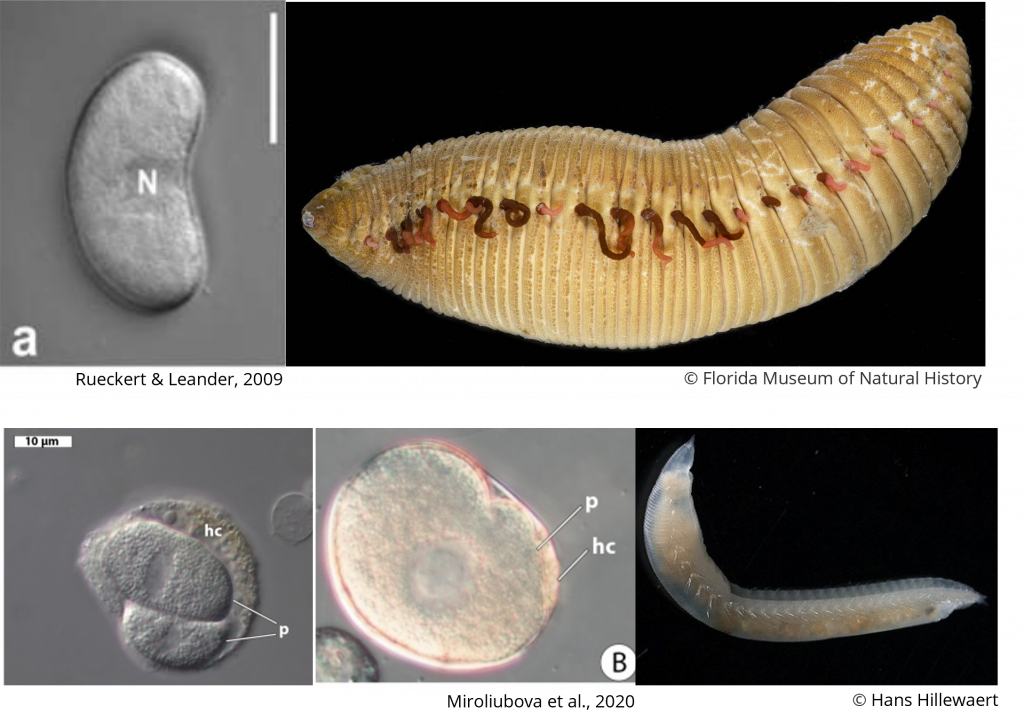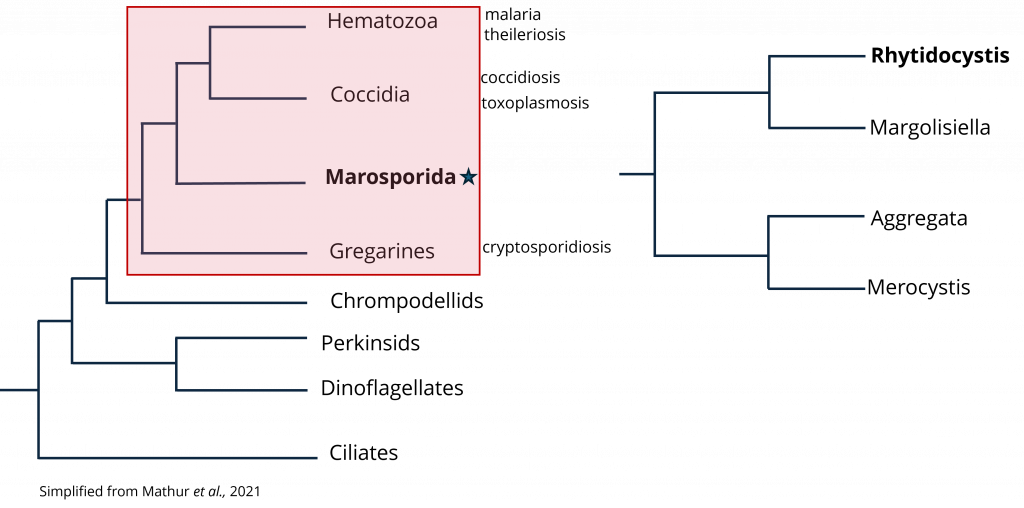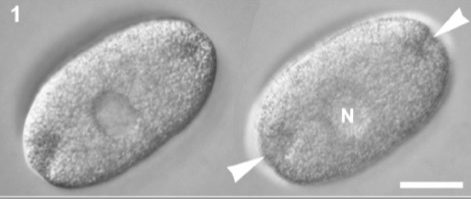Cover image: Rhytidocystis polygordiae from the intestines of a polychaete Polygordius sp. (Scale bar = 15 μm) from Leander & Ramey, 2006. https://doi.org/10.1111/j.1550-7408.2006.00109.x
For this month’s group, I’m introducing another group of enigmatic protists, the family Rhytidocystidae. They belong to the phylum Apicomplexa, which is known for many parasitic species of high economical and medical importance, such as the malaria parasites (Plasmodium), Cryptosporidium and Toxoplasma gondii, just to name a few. I came across these critters while doing my PhD research and, like many other apicomplexans that do not have a direct effect on the daily life of us humans, rhytidocystids are highly understudied from both their biology and species diversity point of view.
But we do know something about them. Like many of their relatives, the marine gregarines, rhytidocystids infect the digestive tracts and coelomic spaces of polychaete worms (Figure 1.) but have also recently been found in marine flatworms. The diversity and host range are likely to be much higher and recent studies suggest that many protists that have historically been recorded as identified as “gregarines”, “sporozoans” or “apicomplexans” observed in different marine invertebrate groups most likely involve rhytidocystids as well. So far, 8 species have been properly described. Rhytidocystids have a circumboreal distribution, as they have been found from hosts in the Northwestern Pacific, Northern Atlantic in both west and east, as well as the Arctic Sea. They seem to also tolarate brackish water habitats since one undescribed rhytidocystid has also been found in the Baltic Sea.

It has also been suggested that the development of rhytidocystids begins intracellularly, like coccidians, but individuals continue to grow epicellularly similar to many gregarines. However, unlike gregarines, rhytidocystis trophozoites do not exhibit any mobility but remain embedded in the epithelium. It is currently not known how these organisms transmit to new hosts, but it is likely that they use the same route as their close relatives, gregarines and coccidians, the oral-fecal transmission where a new host accidentally ingests the transmission stages (oocysts) from the environment.
The share of characters between rhytidocystids and their sister taxa gregarines and coccidians has made inferring their phylogeny a bit puzzling in the past. Originally, rhytidocystids were thought to be unusual gregarines that lack gametes or fertilization. In 1979, Levine established the order Agamococcidia within Coccidia where he placed rhytidocystids along with a single species containing family Gemmocystidae. However, current knowledge based on multiprotein phylogenetics is that they form a completely new class named Marosporida together with other marine invertebrate infecting apicomplexan genera Aggregata, Merocystis, and Margolisiella.

Maybe in the future when more species in this group are described, we will get abetter understanding on the evolution of the important apicomplexan parasites and find new possibilities to prevent the diseases caused by them.
Further reading
- Leander, B.S. & Ramey, P.A. (2006). Cellular Identity of a Novel Small Subunit rDNA Sequence Clade of Apicomplexans: Description of the Marine Parasite Rhytidocystis polygordiae n. sp. (Host: Polygordius sp., Polychaeta). J Eukaryot Microbiol, 53: 280-291.
- Levine, N.D. (1979), Agamococcidiorida ord. n. and Rhytidocystidae fam. n. for the Coccidian Genus Rhytidocystis Henneguy, 1907. J Protozool, 26: 167-168.
- Mathur, V., Kwong, W.K., Husnik, F., Irwin, N.A.T., Kristmundsson, Á., Gestal, C., Freeman, M. & Keeling, P.J. (2021). Phylogenomics Identifies a New Major Subgroup of Apicomplexans, Marosporida class nov., with Extreme Apicoplast Genome Reduction. Genome Biol Evol, 13: evaa244
- Miroliubova, T.S., Simdyanov, T.G., Mikhailov, K.V, Aleoshin, V.V., Janouškovec, J., Belova, P.A. & Paskerova, G.G. (2020) . Polyphyletic origin, intracellular invasion, and meiotic genes in the putatively asexual agamococcidians (Apicomplexa incertae sedis). Sci Rep 10, 15847.
- Rueckert, S.& Leander, B.S. (2009). Phylogenetic position and description of Rhytidocystis cyamus sp. n. (Apicomplexa, Rhytidocystidae): a novel intestinal parasite of the north-eastern Pacific ‘stink worm’ (Polychaeta, Opheliidae, Travisia pupa). Mar Biodiv 39, 227–234.
- Van Steenkiste, N.W.L., Wakeman, K.C., Söderström, B. et al. (2023). Patterns of host-parasite associations between marine meiofaunal flatworms (Platyhelminthes) and rhytidocystids (Apicomplexa). Sci Rep 13, 21050.
![]()
